19 Top Things to Do at Mammoth Hot Springs (Yellowstone National Park)
One of several “hubs” in Yellowstone National Park, along with places like Canyon Village, Old Faithful and Lake Village, Mammoth Hot Springs is the gateway to the rugged north of Yellowstone.
It is home to the park headquarters, the original heart of park management, as well as many facilities and visitor services.
Mammoth Hot Springs is also one of only a few places in Yellowstone that remain open throughout the year. As such, you can visit the Mammoth Hot Springs area in winter, spring, summer and fall.
While many day visitors limit their time in Yellowstone National Park to famous locations like Old Faithful and the Grand Canyon of the Yellowstone on the so-called Lower Loop, I strongly recommend giving yourself a couple more days to explore the park’s Upper Loop, too.
The Upper Loop encompasses some of the park’s wildest areas, particularly Blacktail Deer Plateau and the spectacular Lamar Valley, both of which are home to extraordinary numbers of wildlife.
Mammoth Hot Springs sits in the northwest corner of that scenic loop drive, the perfect base camp to explore the north of Yellowstone National Park.
Read on to discover the top things to do at and around Mammoth Hot Springs in Yellowstone National Park.
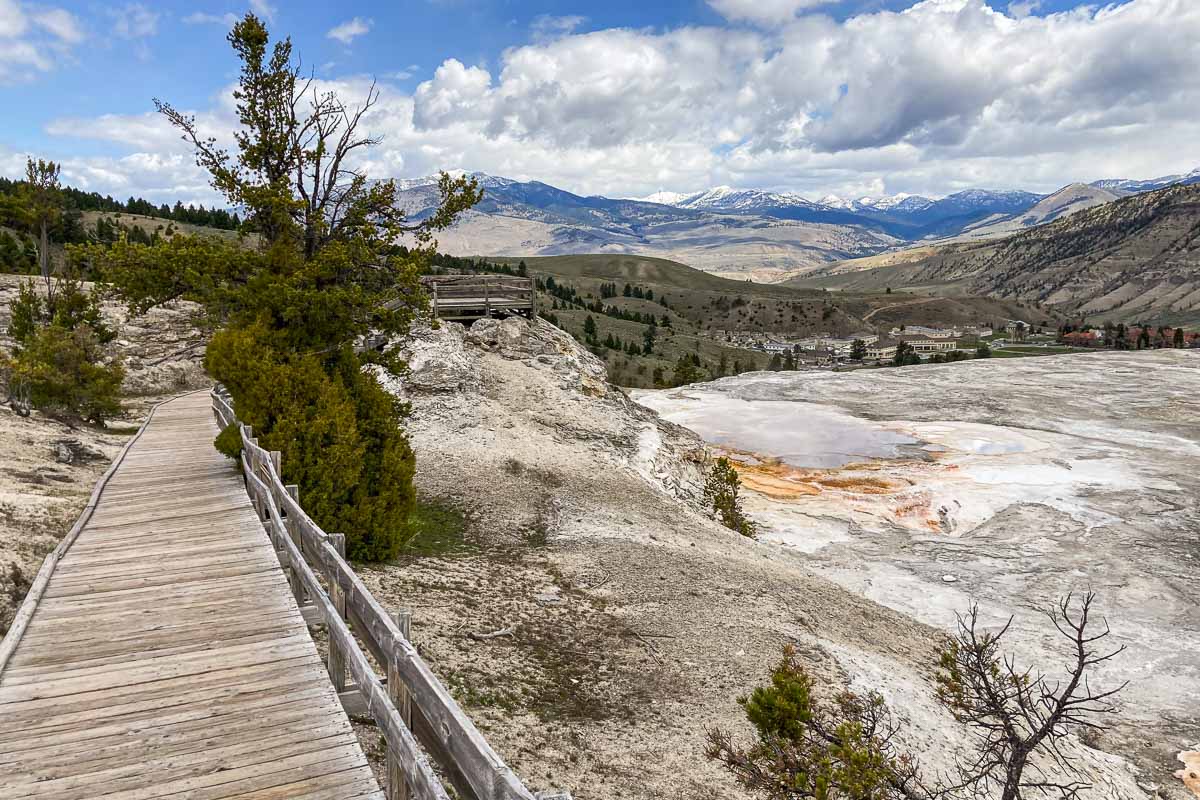
This blog post about what to do at Mammoth Hot Springs contains affiliate links. You can read more about our Terms of Use / Disclosure here.
19 Top Things to Do At and Near Mammoth Hot Springs, Yellowstone National Park
Below, I’ve compiled a bunch of fun things to do at Mammoth Hot Springs itself.
I also share several activities you can do in the general vicinity of Mammoth Hot Springs, all of which are within a 15-minute drive from the Mammoth Hot Springs Historic District.
This is followed by section about wildlife safety when exploring Mammoth Hot Springs, and some recommendations of where to stay, too.
And lastly, at the end of this post you’ll find an FAQ section with answers to some common questions related to visiting Mammoth Hot Springs in Yellowstone.
8 Best Things to Do At Mammoth Hot Springs, Yellowstone
Let’s start with the top activities at Mammoth Hot Springs, which is the tourist center of this corner of Yellowstone National Park.
There’s lots to see and do here, from touring an old U.S. Army fort to exploring spectacular hot spring terraces, and observing iconic wildlife.
Explore the Albright Visitor Center
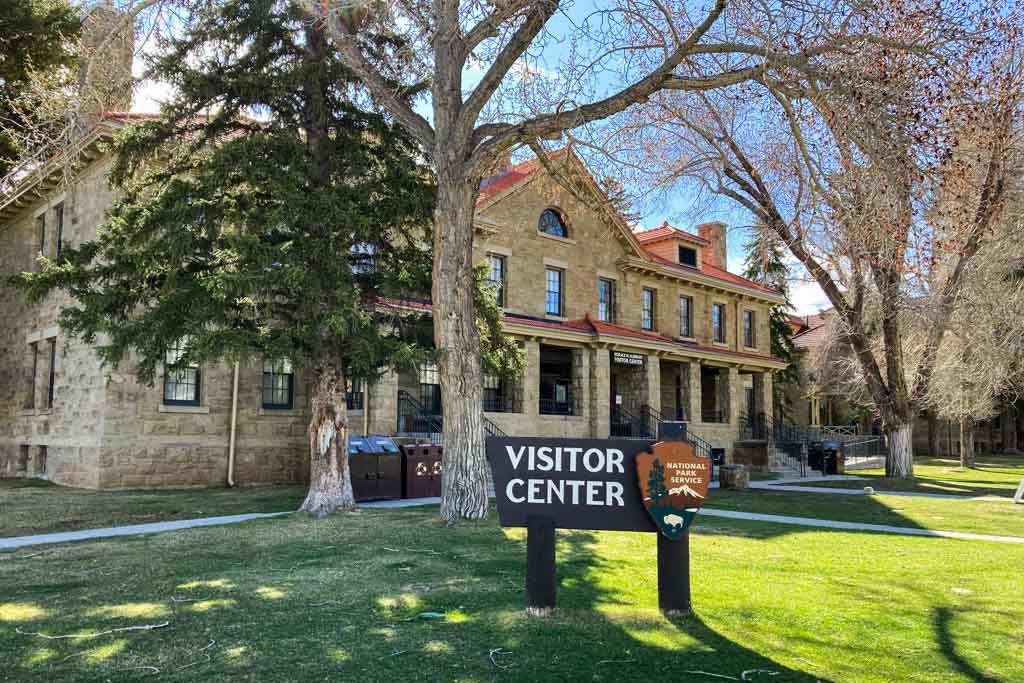
The Albright Visitor Center is the best place to start your time in Mammoth Hot Springs.
Located in a 1909 building that used to house single U.S. Army officers before the National Park Service was created, the visitor center has a wealth of information on all things Yellowstone.
You can get more information about things to do at Mammoth Hot Springs or elsewhere in Yellowstone, learn about the park’s history, talk to a ranger, see current road and trail conditions, and get permits.
Additionally, the Albright Visitor Center also has excellent exhibits and a souvenir shop. Free Wi-Fi is available, too.
Tour Historic Fort Yellowstone
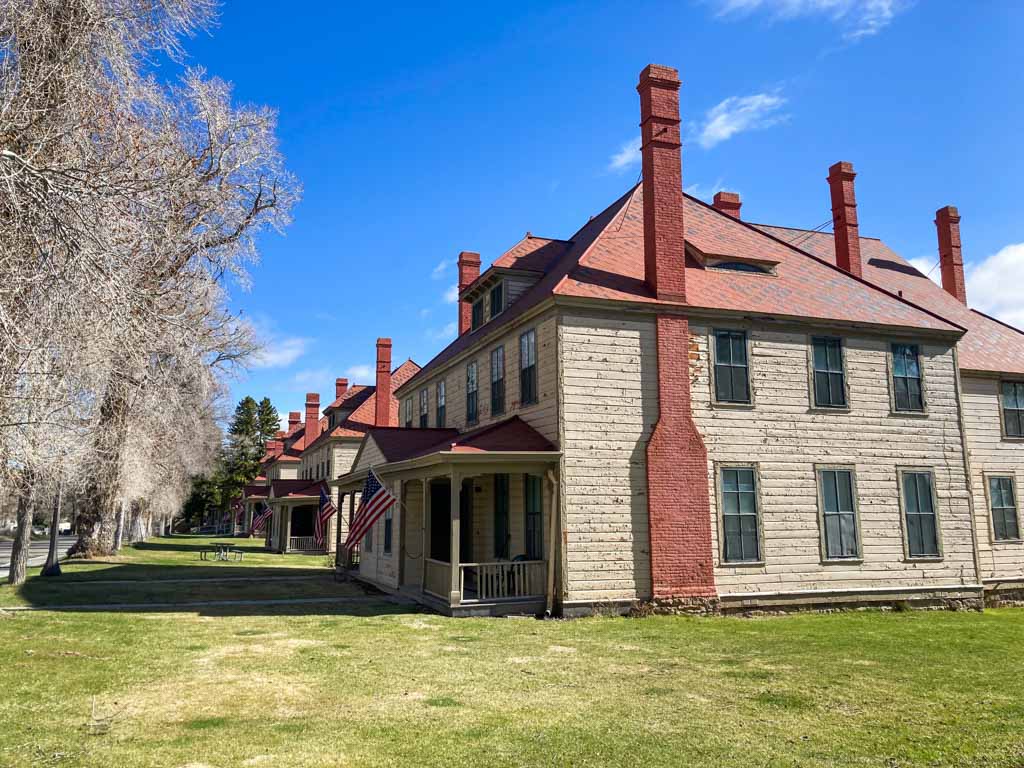
The Albright Visitor Center is actually part of historic Fort Yellowstone. The fort encompasses 35 buildings that date from the 1890s and early-1900s, which is when the U.S. Army administered Yellowstone National Park.
Fort Yellowstone was built more than a decade after Yellowstone became a national park. During the park’s early years, its first superintendents had trouble preventing vandalism, poaching, and squatting in this vast wilderness park.
The U.S. Army arrived in 1886, among them some of the famous Buffalo Soldiers, and began building what is now Fort Yellowstone. Those soldiers can be regarded as the very first park rangers, taking care of everything from wildlife management and law enforcement to assisting visitors.
Nowadays, Fort Yellowstone still stands and houses park rangers to this day. It also remains Yellowstone National Park’s headquarters, comprising the Albright Visitor Center, and many offices and administrative buildings.
You can tour Fort Yellowstone on a self-guided walking tour, which is one of the most popular things to do at Mammoth Hot Springs.
It’s right in the middle of the Mammoth Hot Springs Historic District, just across the road from the Mammoth Hot Springs Hotel.
Walk the Mammoth Hot Springs Boardwalks
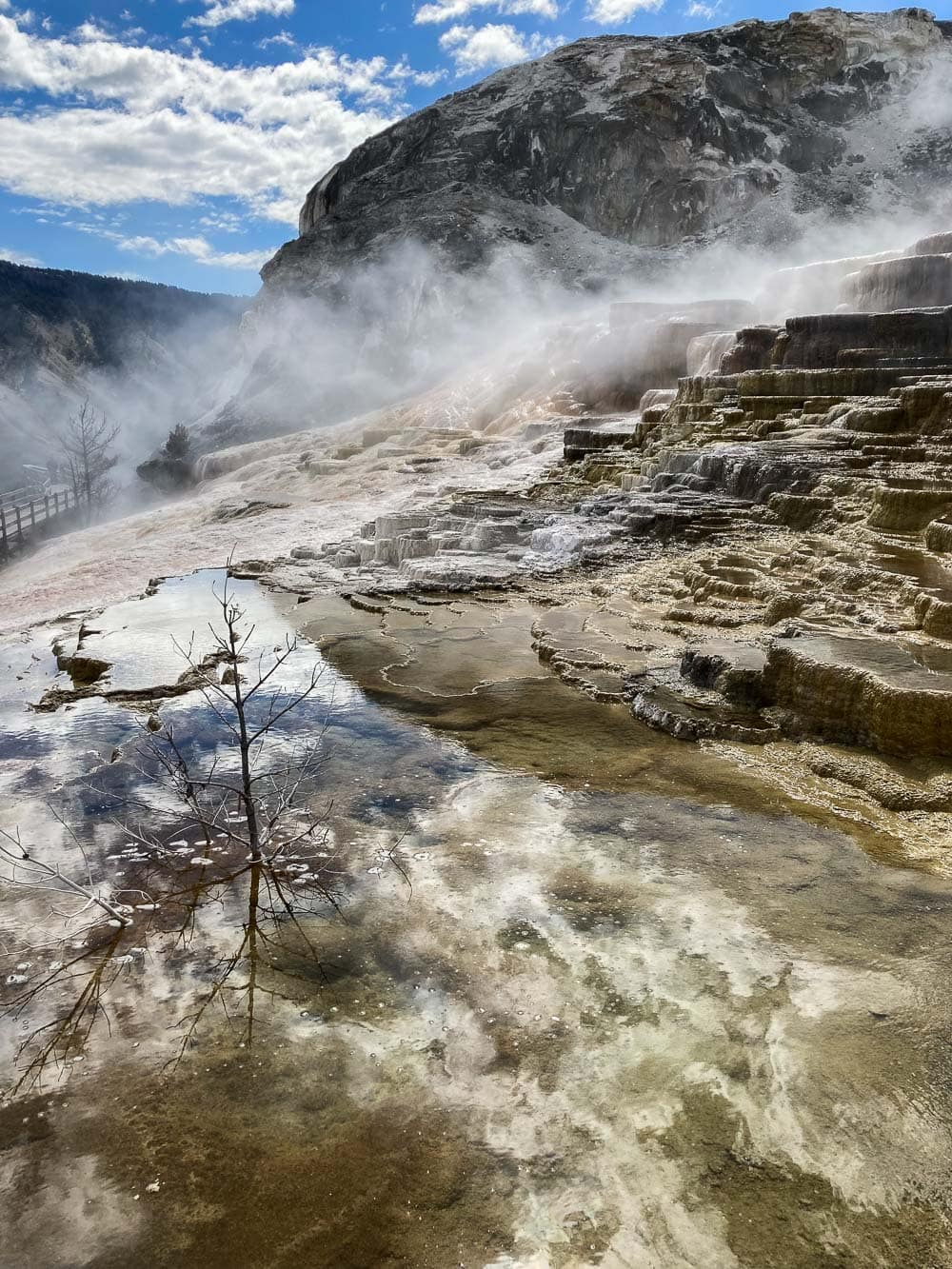
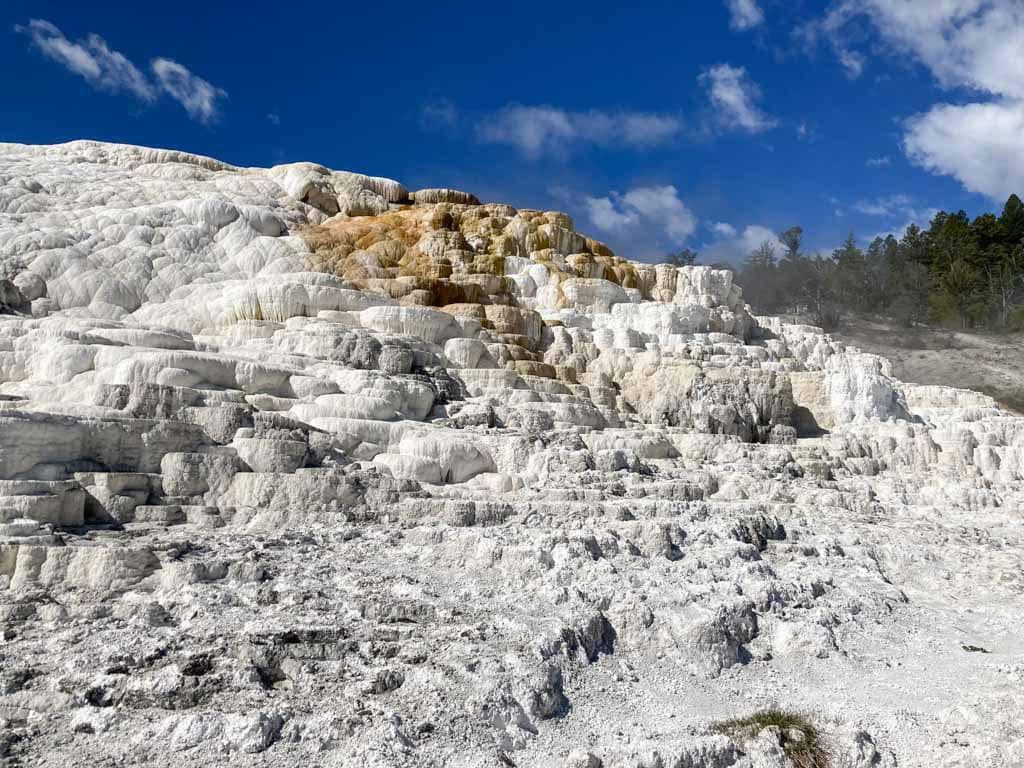
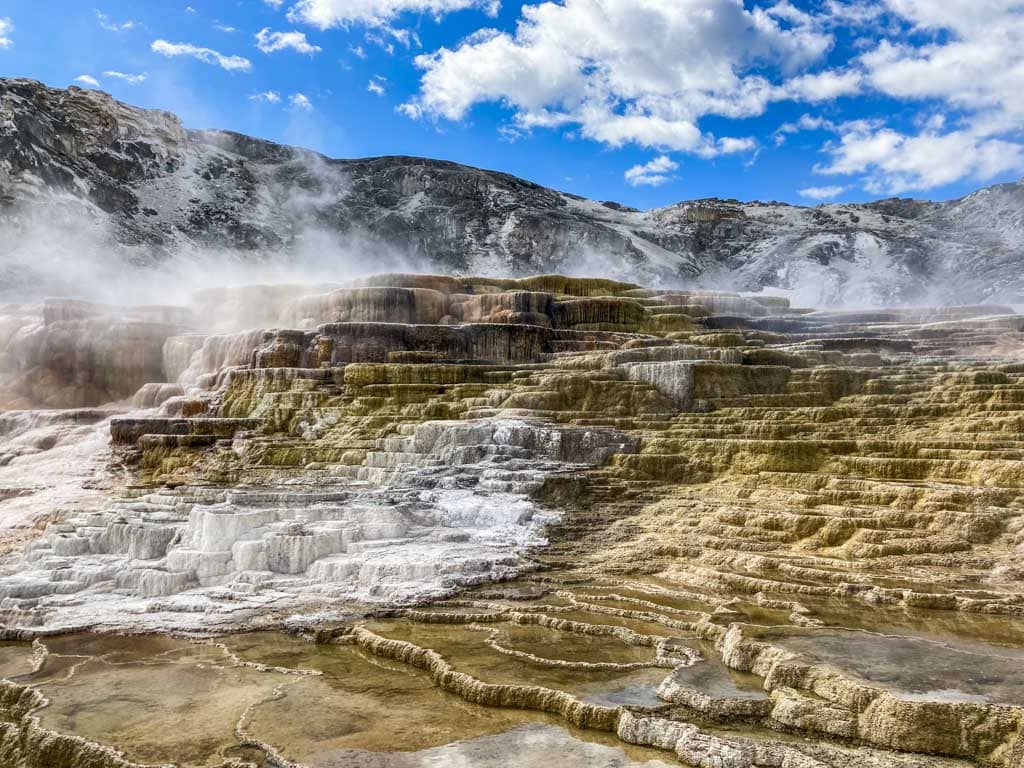
One of the absolute top things to do in Yellowstone National Park is a walk on the Mammoth Hot Springs boardwalks.
One of the park’s many—and among its most extraordinary—hydrothermal areas, Mammoth Hot Springs is a stunning collection of travertine terraces, the result of limestone deposited by hot springs.
In fact, travertine builds up so quickly here, while hot springs dry up and come back to life sometimes overnight, that this is among Yellowstone’s fastest-changing areas. Mammoth Hot Springs literally looks different each year.
So-called thermophiles—heat-loving bacteria I’ll talk more about below—add a wide range of color to the bright chalk-white travertine, creating a magnificent natural wonder.
A network of boardwalks and stairways runs through and around the Lower Terraces. On these boardwalks, you can see marvelous geothermal features like Palette Spring, Minerva Terrace, and Cleopatra Terrace from up close.
At the top of the Lower Terraces, Canary Spring is a gorgeous white-and-orange hot spring, arguably the most beautiful feature in this particular area.
The Upper Terraces, on the other hand, can be explored on the 1-mile Upper Terrace Drive, a one-way drive that’s usually open between mid-May and November.
Learn About Thermophiles
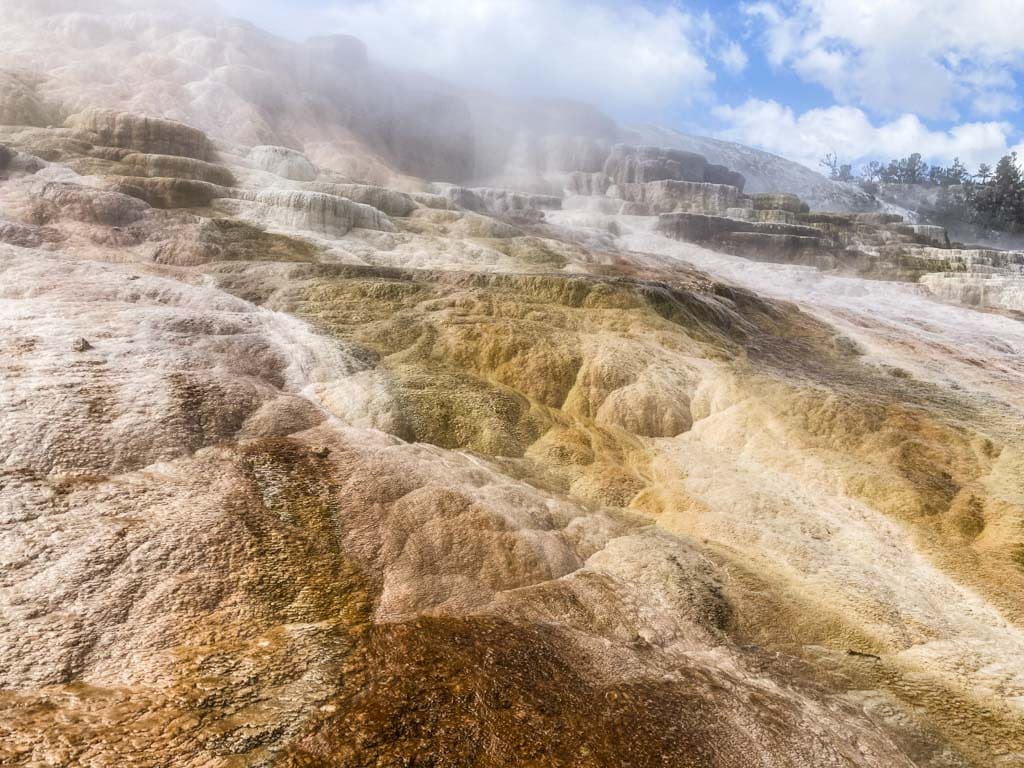
Anyone who’s even a little bit interested in chemistry, biology, natural history, or other natural sciences will enjoy learning about Yellowstone’s thermophiles. And Mammoth Hot Springs is the perfect place to do that.
While many people visit Yellowstone to see its megafauna, such as bears, bison, elk, and wolves, most of life in Yellowstone National Park is actually microscopic. One of the most fascinating organisms in the park are thermophiles, heat-loving microorganisms that thrive in Yellowstone’s hot springs.
These tiny creatures are extraordinary in the sense that they don’t just survive, but positively thrive in the most extreme of environments. They’re found in water so hot it would blister your skin, in water as acidic as the fluid in your car’s battery.
Moreover, the thermophiles in Yellowstone National Park are exceptionally diverse, too, with species from all three domains of life: bacteria, archaea, and eukarya (which also includes humans).
Although you can’t see these miniscule microbes with the naked eye, you can see, and even smell, the things they create.
Specifically, virtually all the vibrant colors in the famous hot springs of Yellowstone, including at Mammoth Hot Springs, are the result of thermophiles. Each color represents a (slightly) different temperature.
You can learn more about thermophiles on the Lower Terraces boardwalks at Mammoth Hot Springs.
Alternatively, you can also watch this 11-minute video about thermophiles on the Yellowstone National Park website.
See the Liberty Cap Formation
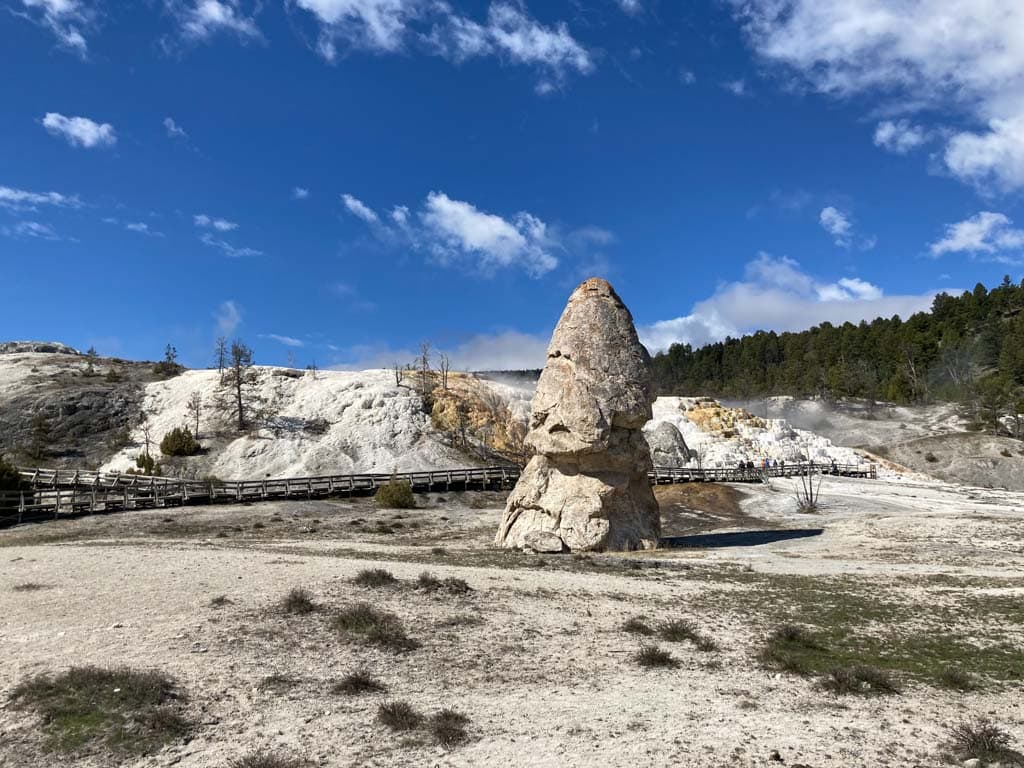
Liberty Cap, located at the base of the Lower Terraces, is a solidified 37-feet-high former hot spring cone.
A striking geological formation, it used to be the inside of a hot spring that remained active for a very long time in the same place.
For maybe hundreds of years, the internal pressure of the hot spring ejected water, while mineral deposits accumulated slowly.
The 1871 Hayden Geological Survey gave Liberty Cap its current name. They thought “it resembled the peaked knit caps symbolizing freedom and liberty during the French Revolution,” the Park Service explains.
Visit the Mammoth Hot Springs Hotel
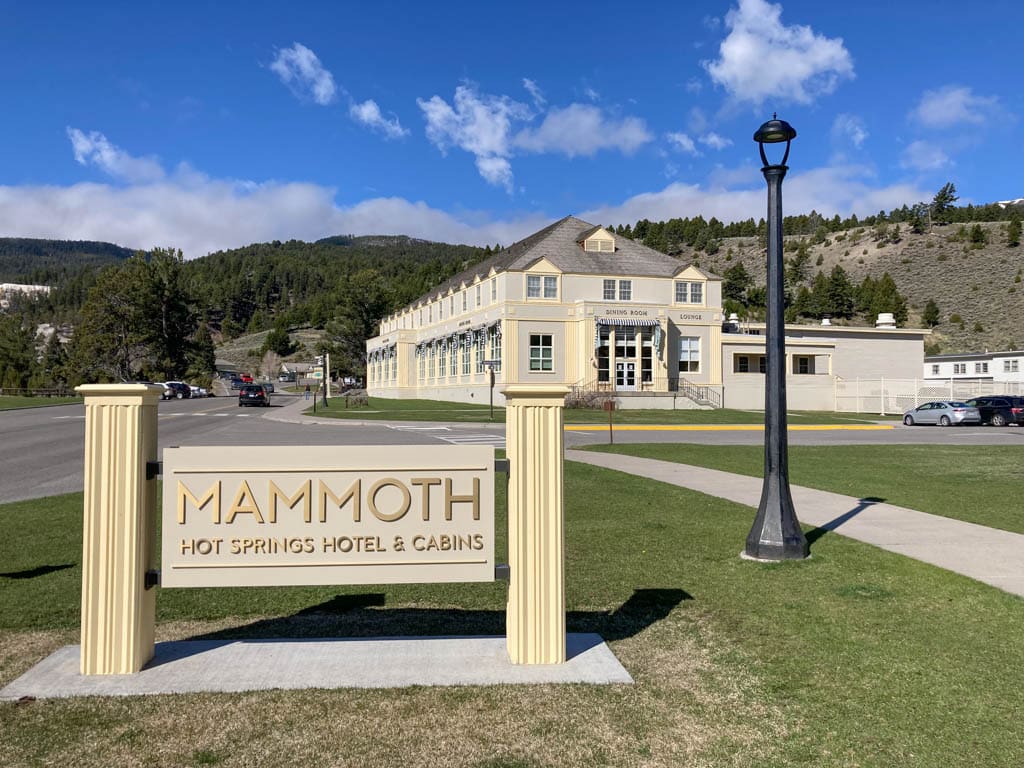
One of the most historic hotels in Yellowstone, the Mammoth Hot Springs Hotel as it stands today was constructed in 1936, but it did retain a wing of guest rooms that dates from 1911. Even if you’re not staying there, it’s a wonderful place to visit.
A particularly fascinating interior feature is the hotel’s Map Room, which houses a huge wooden map of the United States made with fifteen different types of wood from nine countries.
This atmospheric room is a wonderful place to wind down after a day filled with Mammoth Hot Springs activities. There are board games and, often, live piano music to enjoy.
From the historic hotel, you can easily walk over to the iconic Mammoth Hot Springs, after which it was named.
Observe Bison Grazing on the Lawn
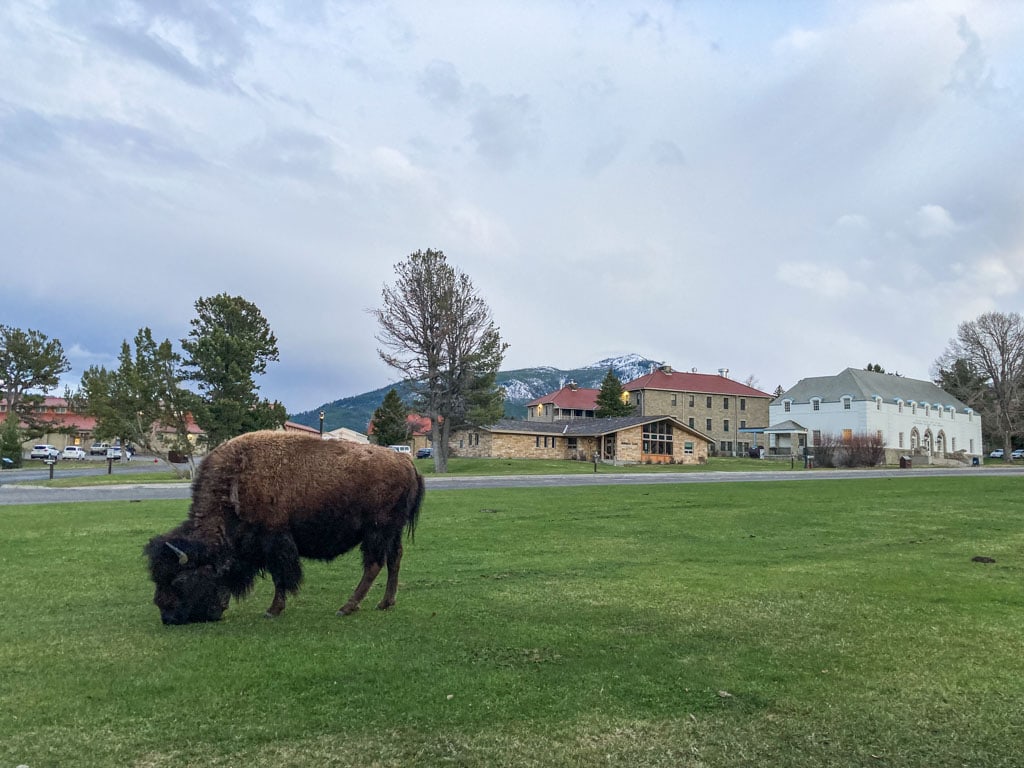
Observing bison graze on the lawns in front of the Mammoth Hot Springs Hotel or Mammoth Post Office is definitely one of the coolest activities in Mammoth Hot Springs.
Bison often come to Mammoth Hot Springs at dawn or dusk for breakfast or dinner, relishing the manicured lawns of the historic district. In fact, I’d say that Mammoth Hot Springs is one of the best places to see bison in Yellowstone.
It’s difficult to predict when and where the bison will show up, though, but if you spend a couple of days in Mammoth Hot Springs, you should have an excellent chance of seeing them.
For example, I spent two nights there in spring and saw bison every single morning and evening.
I saw them at the Mammoth Post Office, wandering through Fort Yellowstone, and near the Lower Terraces boardwalk.
Look For Elk on the Surrounding Slopes
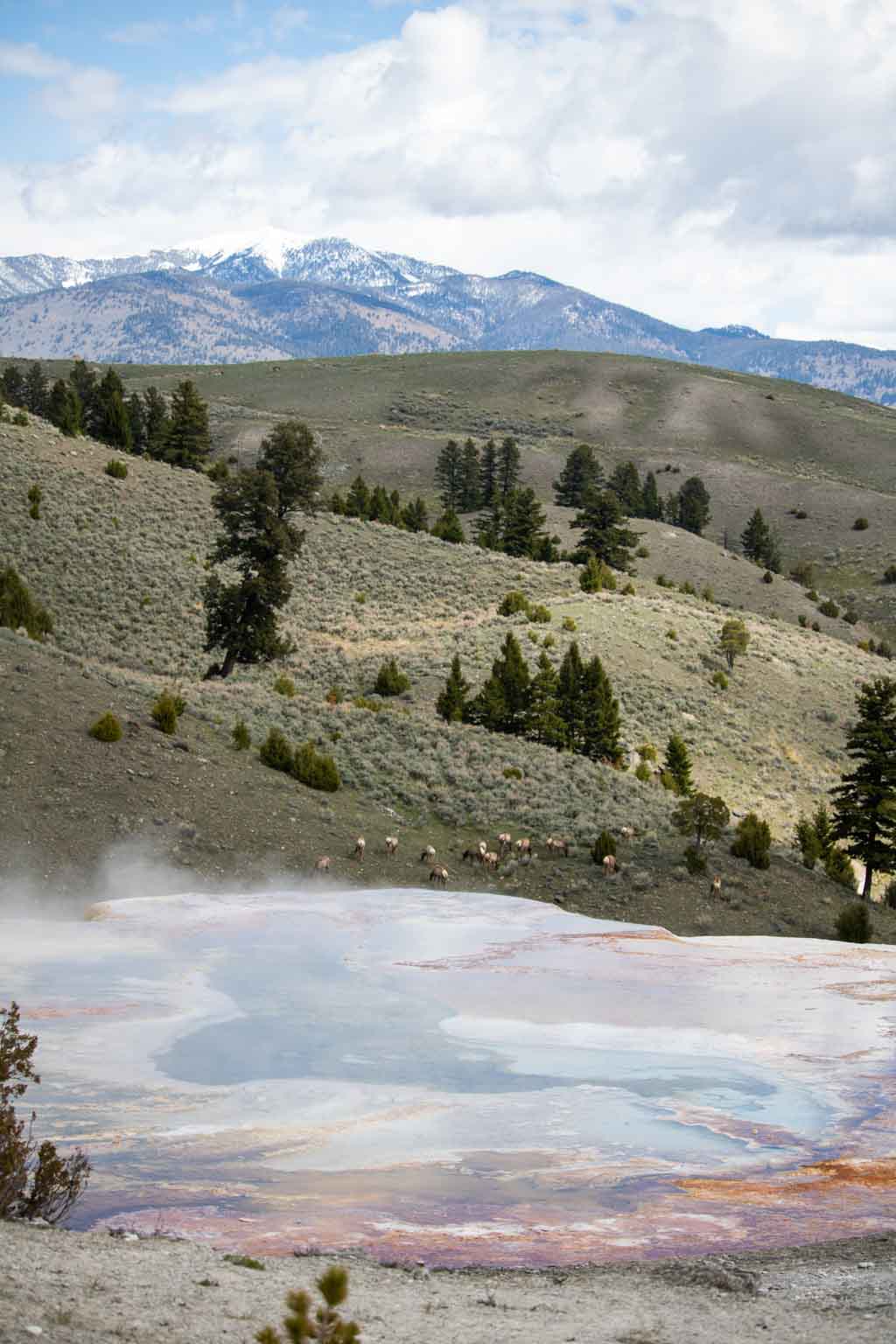
“Elk are common in Mammoth Hot Springs,” the National Park Service says, so you have a great chance of seeing these large ungulates during your visit.
Sometimes, they stroll into the Mammoth Hot Springs Historic District to munch on its grass and shrubs. However, they’re more commonly seen on the slopes around the hot springs terraces, though.
So, when exploring Mammoth Hot Springs and its boardwalks, make sure to look around you, too, and beyond the colorful hot springs. You might see a herd of elk amid the trees or on the open slopes.
4 Best Things to Do Near Mammoth Hot Springs, Yellowstone (North)
A lot of people who visit Mammoth Hot Springs either arrive through the north entrance of Yellowstone National Park or visit Gardiner on a day trip.
This beautiful area just north of Mammoth Hot Springs is home to an abundance of wildlife, including birds of prey, bison, elk, bighorn sheep and the occasional bear. This is also where you’ll find the iconic Roosevelt Arch.
Visit Gardiner, Montana
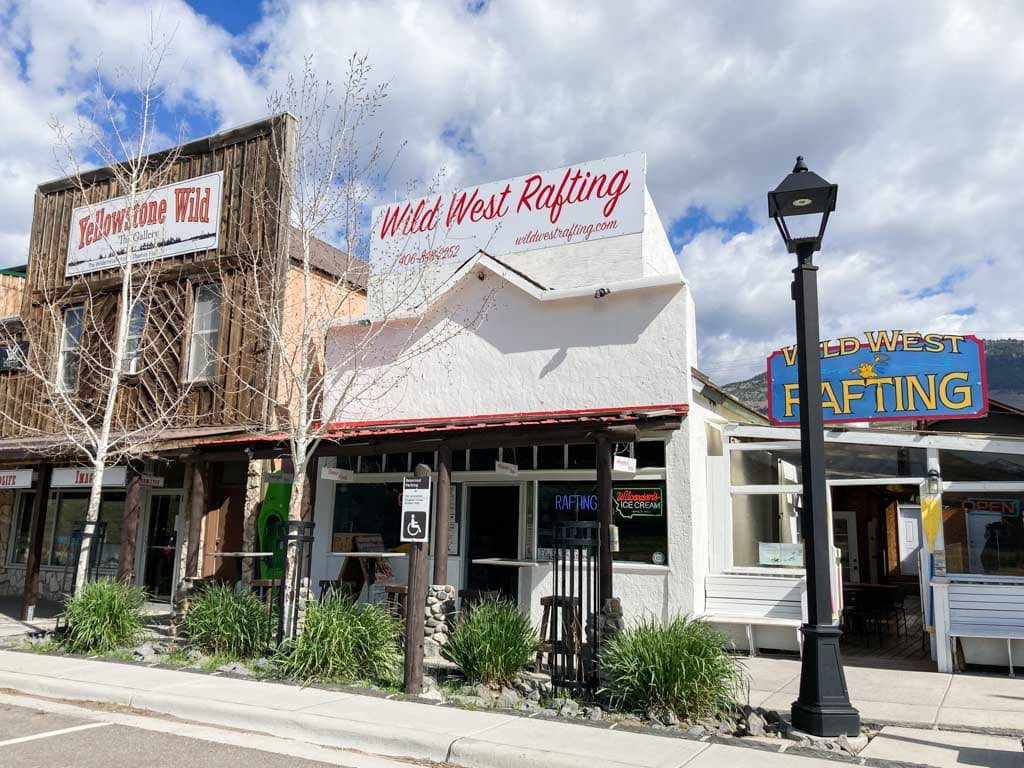
Gardiner, Montana, is one of the gateway towns to Yellowstone National Park. It sits on the banks of the Gardner River, just outside the park’s northwestern boundary.
This small town is home to a number of visitor services and facilities, including accommodations, restaurants, and numerous shops.
Gardiner is also where you’ll find the excellent Heritage and Research Center, which houses Yellowstone’s museum collection, archaeology lab, research library, and archives. It’s situated near the Roosevelt Arch.
Additionally, the non-profit Yellowstone Forever Institute is based in Gardiner as well.
Walk Through the Iconic Roosevelt Arch
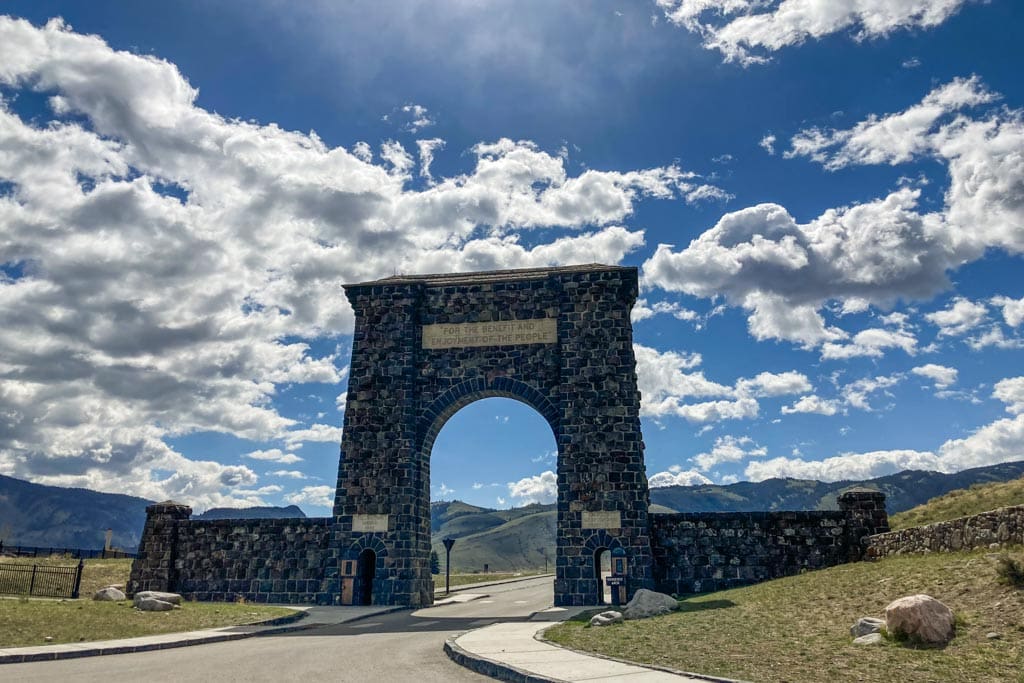
Arguably the most famous structure in Yellowstone, the Roosevelt Arch stands near the park’s north entrance in Gardiner, Montana.
It was built over the road connecting Gardiner to the park’s headquarters at Mammoth Hot Springs. President Theodore Roosevelt, who was vacationing in the park at the time, laid the cornerstone in 1903, thus giving this magnificent stone arch its name.
The famed plaque on the arch contains a phrase from the legislation that created Yellowstone National Park and reads: “For the benefit and enjoyment of the people.”
Today, however, “it would be considered inappropriate to embellish the park’s landscape with such a conspicuous, non-functional structure,” the National Park Service itself says.
Yet, the imposing Roosevelt Arch does serve as a historical marker of a time in U.S. history “when cultural values called for a monumental entrance to Yellowstone.”
You can either drive or walk through the Roosevelt Arch, which is near the modern-day north entrance to the park.
Take a Photo With the Famous Yellowstone National Park Entrance Sign
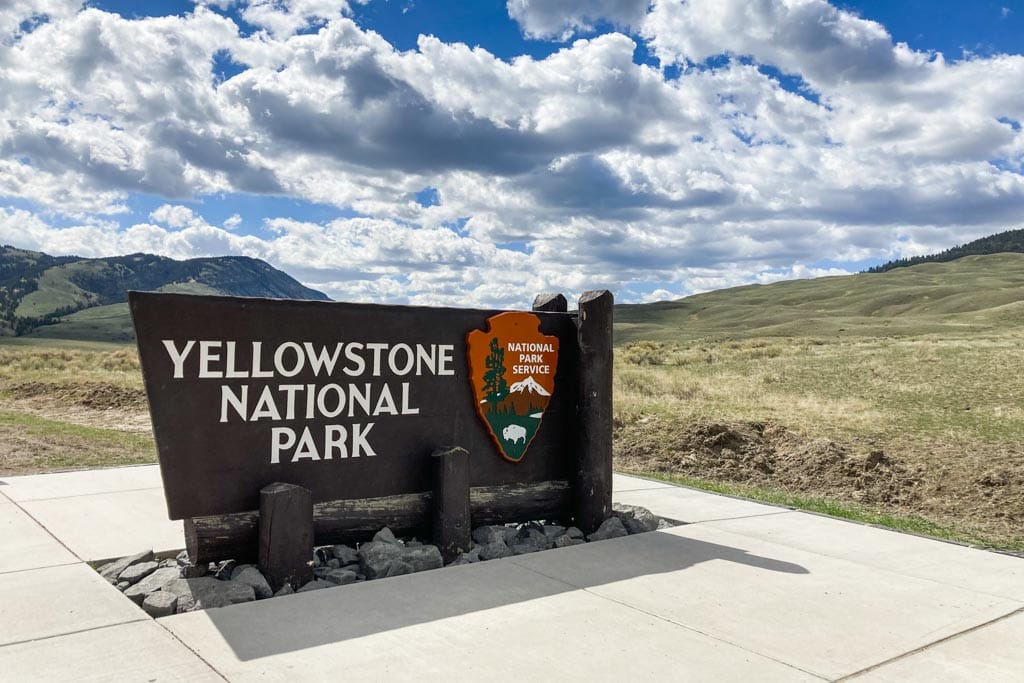
Adjacent to the Roosevelt Arch, you’ll see the famous Yellowstone National Park entrance sign in Gardiner.
It’s a short walk from the arch to the sign, which is backed by the rolling grasslands and mountains of the Northern Range. If you’re lucky, there might be a herd of bison or elk grazing in the flats behind the sign.
Watch Wildlife in Gardner Canyon
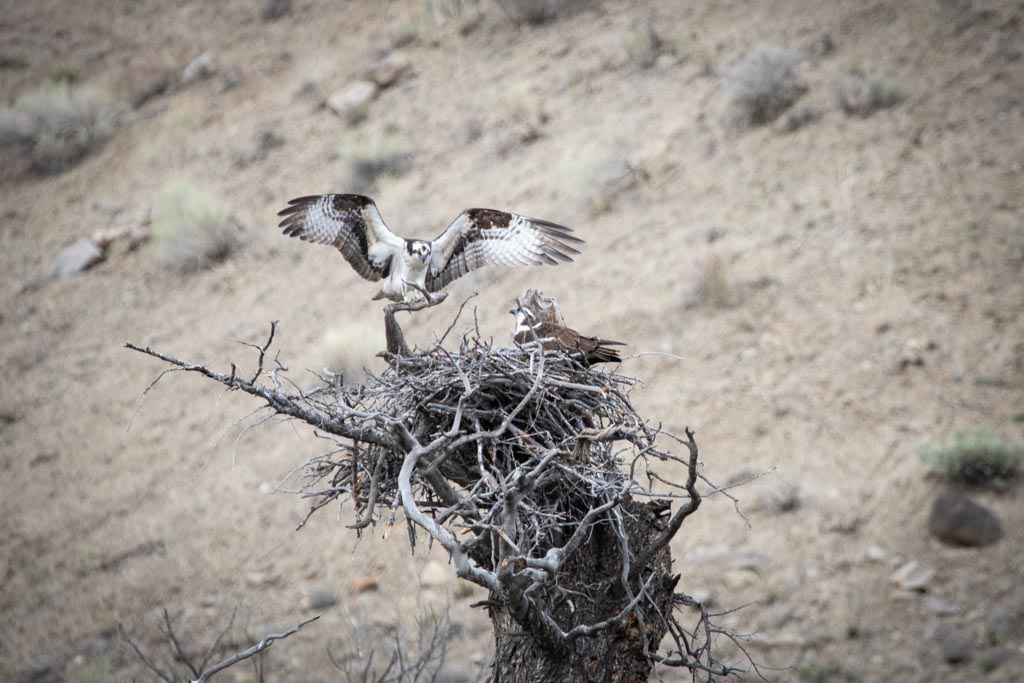
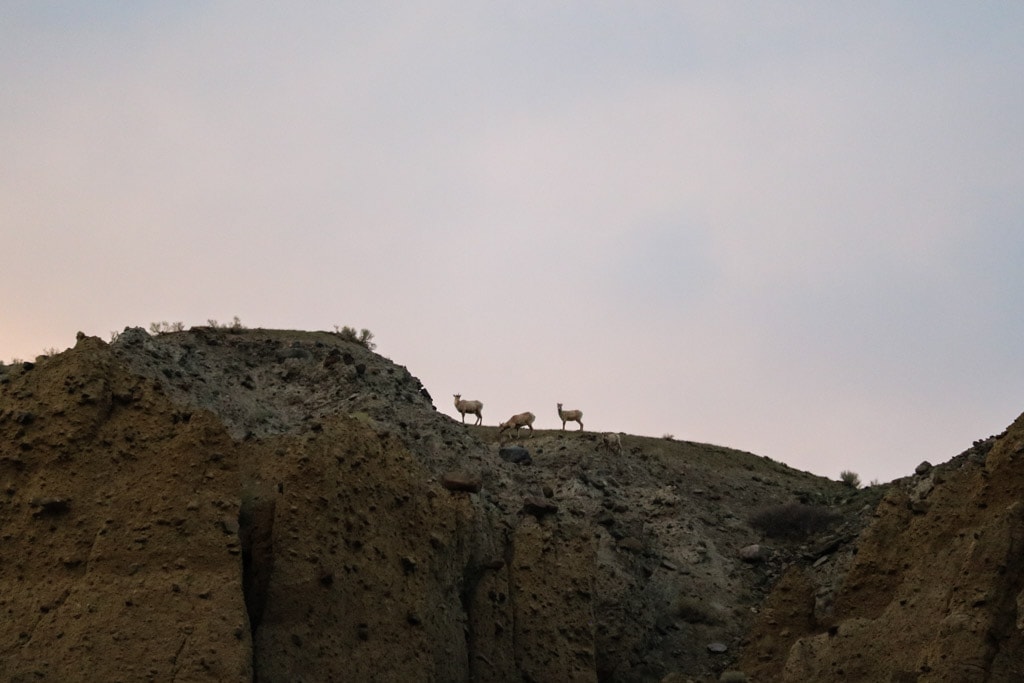
The 5-mile-long road between Mammoth Hot Springs and Gardiner leads through Gardner Canyon, carved by the Gardner River.
In my opinion, this is one of the most underrated places in Yellowstone to go wildlife watching. I’ve driven that road several times myself—before it got damaged by the historic 2022 flood event—and saw several different animals there.
Look up and around you and you might see some beautiful bird species, such as ospreys, eagles, or kingfishers.
The steep cliffs and ridges in Gardner Canyon are also an ideal habitat for bighorn sheep, while bison, elk, and mule deer enjoy grazing along the river.
3 Best Things to Do Near Mammoth Hot Springs, Yellowstone (South)
To the south of Mammoth Hot Springs are a few fun activities to enjoy, too.
You can hike up to Bunsen Peak for commanding views, see Rustic Falls at the Golden Gate, and go bird watching at Swan Lake.
Drive Through the Golden Gate
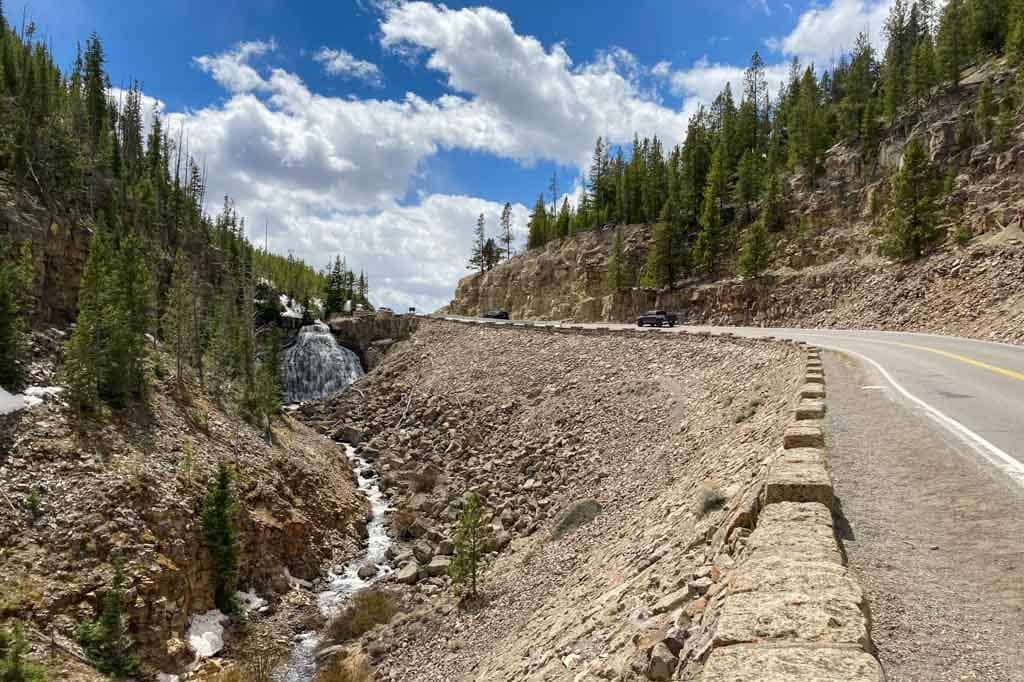
The Golden Gate is a short drive south of Mammoth Hot Springs, its name indicating that this is the “gateway” to the Yellowstone National Park interior.
Here, the road runs through the steep canyon of Glen Creek via a viaduct, flanked by golden-colored rocks.
It’s a wonderful stop when driving from Mammoth Hot Springs to Norris, or simply a fun place to visit on a day trip from Mammoth Hot Springs.
Two small parking lots offer beautiful views of the area. There’s an upper parking lot at the top of Rustic Falls and a lower parking area that provides a head-on view of the waterfall itself.
Especially in spring, Rustic Falls is one of the finest roadside waterfalls in Yellowstone National Park.
Hike to Bunsen Peak
One of the most popular day hikes in the Mammoth Hot Springs area is the Bunsen Peak Trail.
This is a beautiful 4.6-mile roundtrip hike that climbs 1,300 feet through meadows and forests to the summit of Bunsen Peak.
Named after the German scientist Robert Bunsen, who studied geysers in Yellowstone and also invented the Bunsen Burner, the summit provides spectacular panoramic views of Swan Lake Flat, the Gallatin Mountains, Blacktail Deer Plateau, and the Mammoth Hot Springs area.
Note: Grizzly bears are present in this area, so pay attention, don’t hike alone, and always have your bear spray within easy reach.
See Birds at Swan Lake
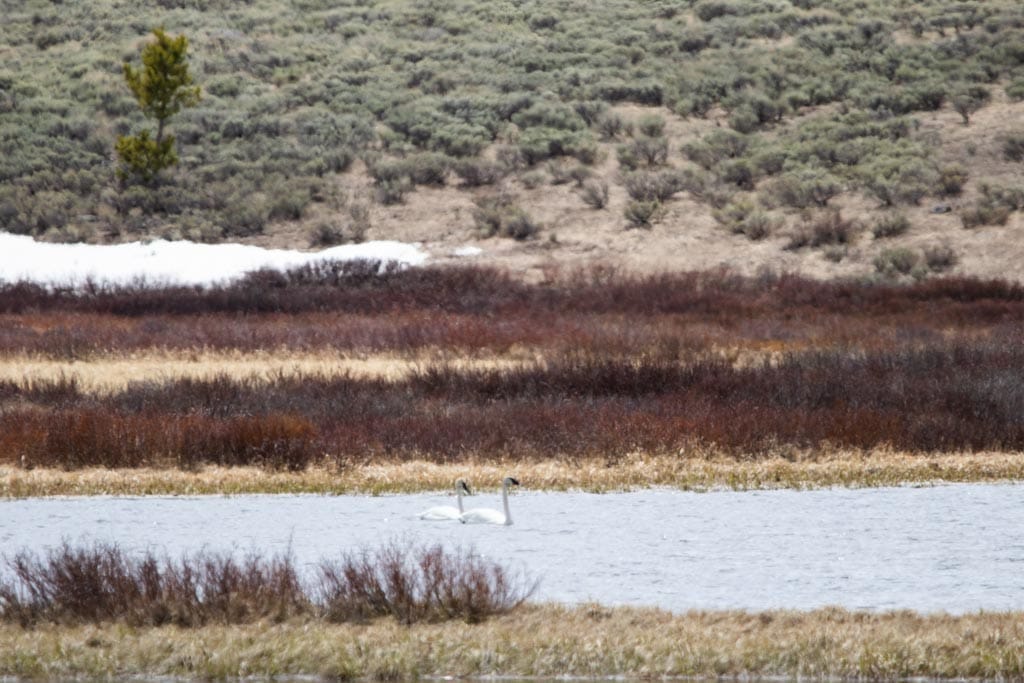
Located just south of the Golden Gate is a nice viewpoint overlooking Swan Lake Flat, with the majestic Gallatin Mountain Range beckoning in the background.
Swan Lake itself gets its name from the trumpeter swans that frequent it, but you can also see a variety of other birds here, including sandhill cranes, ducks, and geese.
Mammals like elk and grizzlies are also common sights in this area. Lucky visitors might even see a pack of wolves in the distance.
4 Best Things to Do Near Mammoth Hot Springs, Yellowstone (East)
When you drive east from Mammoth Hot Springs, you’ll soon find yourself in the sagebrush wilderness of the Blacktail Deer Plateau.
This area features a couple of wonderful waterfalls, superb Northern Range scenery, and excellent opportunities to see grizzly bears.
Drive Across Blacktail Plateau
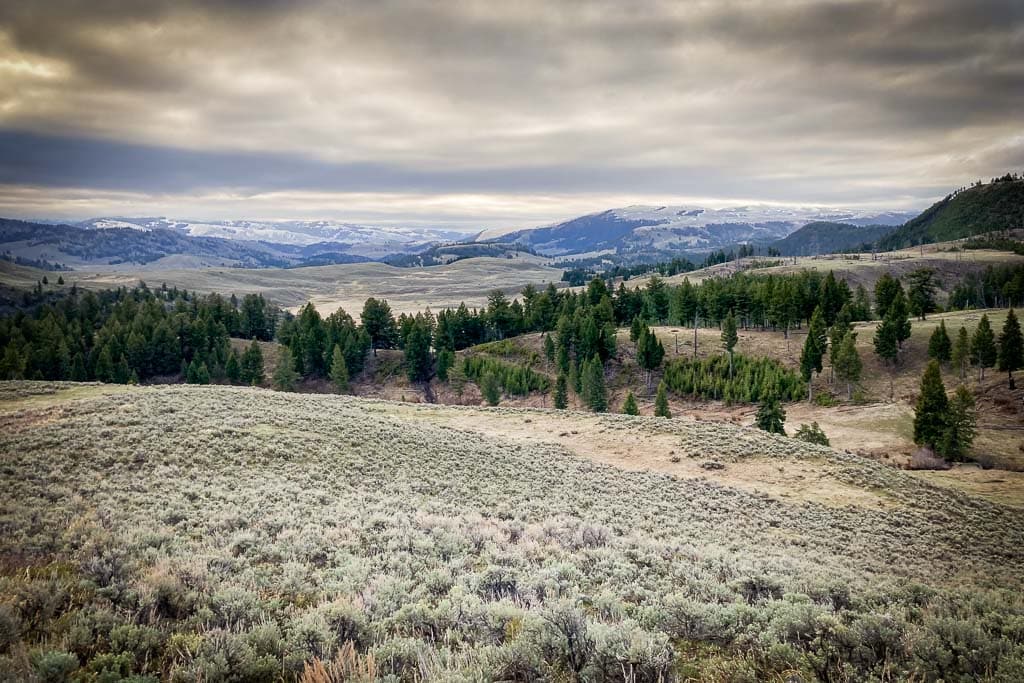
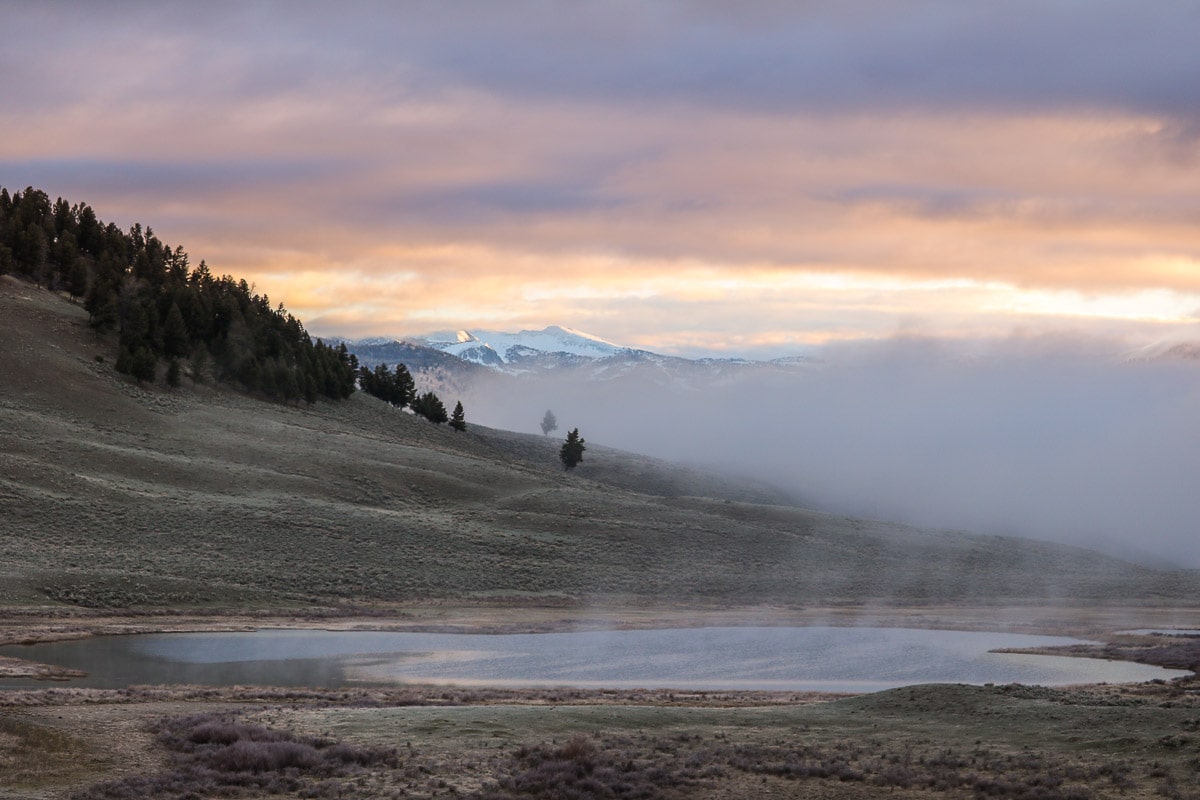
When I was staying at Mammoth Hot Springs, one of my favorite things to do was going for a drive across Blacktail Deer Plateau at dawn.
I got up every single morning for this awesome drive and I recommend you do the same.
Blacktail Deer Plateau is much more than a drive-through area, though. It’s a massive highland with snowcapped mountains, expansive meadows, mysterious pine forests, reflective ponds, waterfalls and—do I have to say it?—lots of wildlife.
On the way from Mammoth Hot Springs to the Tower-Roosevelt area, you’ll pass beautiful spots like Undine Falls, the Wraith Falls trailhead, and Blacktail Pond, just to name a few. The seasonal Blacktail Plateau Drive is a fantastic detour, too.
I just love the tranquility and serenity of Blacktail Deer Plateau in the morning and, on top of that, I lost count of the many animals I saw there.
Mule deer, bison, both black bears and grizzly bears, marmots, pronghorn, elk, wolves,… You can see all of those and more!
See Undine Falls
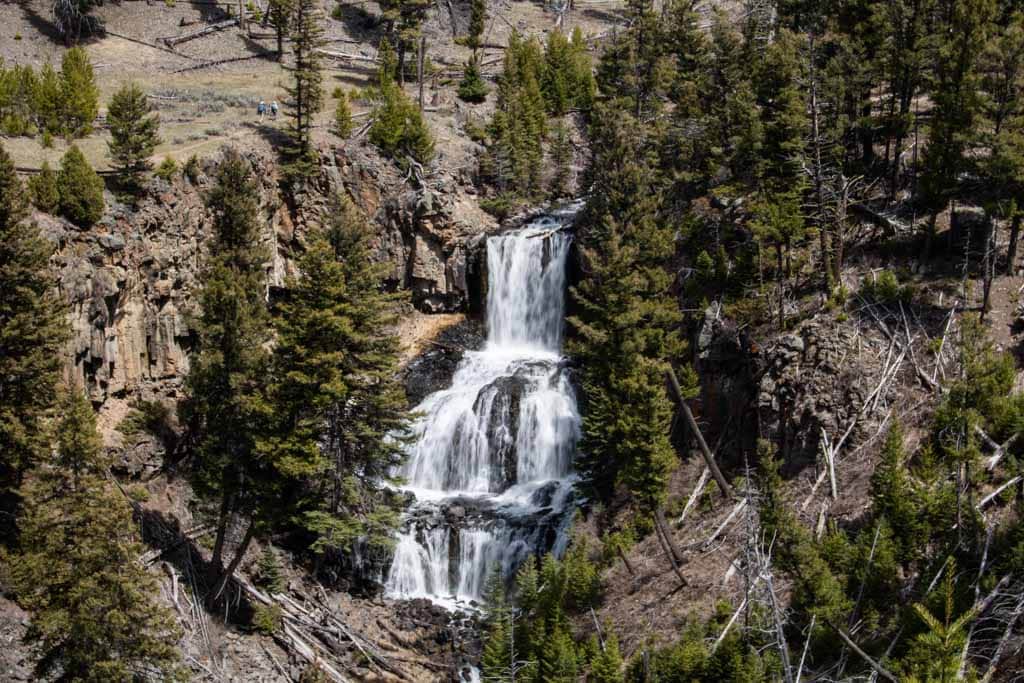
There are a few wonderful waterfalls in the general vicinity of Mammoth Hot Springs. A particularly beautiful one is Undine Falls, situated about 4.5 miles east of Mammoth Hot Springs
You can see this 60-foot three-tier waterfall in Lava Creek from a scenic viewpoint at a roadside parking lot.
For a much closer view of Undine Falls, on the other hand, you can hike the Lava Creek Trail, a nice 4.2-mile point-to-point hike along Lava Creek and the Gardner River.
Its two trailheads are across the road from the Mammoth Campground or across the road from the Lava Creek Picnic Area, respectively.
Hike to Wraith Falls
One of the shortest and easiest hikes near Mammoth Hot Springs, the Wraith Falls Trail starts just east of Undine Falls.
This 1-mile roundtrip hike takes you across sagebrush-covered meadows, interspersed with forest, to the lovely Wraith Falls.
It’s a fairly flat trail that’s suitable for families with children, but remember that grizzly bears are present in this area.
Note: Grizzly bears frequent the general area around both Undine Falls and Wraith Falls, so carry bear spray while hiking and know how to use it! More about grizzly bear safety below.
Look For Grizzlies in the Sagebrush
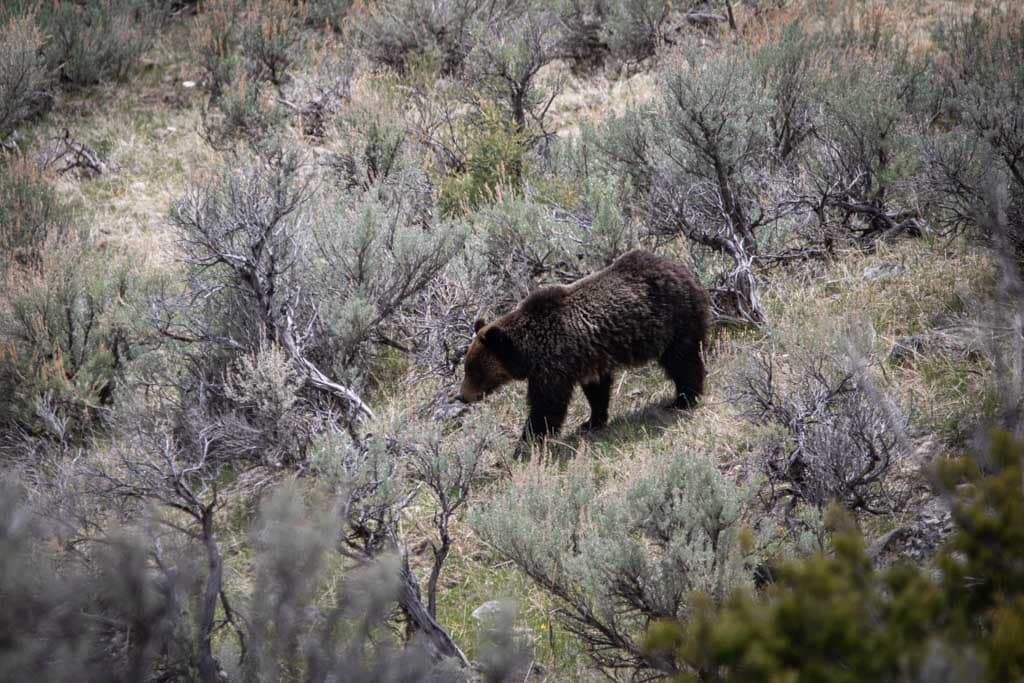
I’ve said it a few times before: grizzlies are present in the sagebrush meadows and slopes near Mammoth Hot Springs. Although they rarely venture into the busy historic district, they do frequent the quieter areas around it.
When driving from Mammoth Hot Springs, look for them wandering on hillsides, across sagebrush flats, or near the forest edges.
I saw a huge male grizzly just off the road mere minutes east of Mammoth Hot Springs on my way to Blacktail Deer Plateau. You may not always see them, though, but they’re definitely around.
Wildlife Safety At and Around Mammoth Hot Springs
In the spirit of “better safe than sorry,” this section serves as a caution and warning. People do get chased, trapped, and/or injured by animals at Mammoth Hot Springs every year.
The vast majority of incidents with wildlife involve bison and elk, which are especially dangerous during the spring calving season and the fall rut. Bears are, of course, also present in the area and potentially dangerous, but serious encounters are rare.
Either way, it’s essential to be aware of your surroundings and animal activity anywhere in Yellowstone National Park, even in busy areas like Mammoth Hot Springs.
Refer to the following wildlife safety guides to ensure your visit remains safe and enjoyable for all parties involved, including the animals.
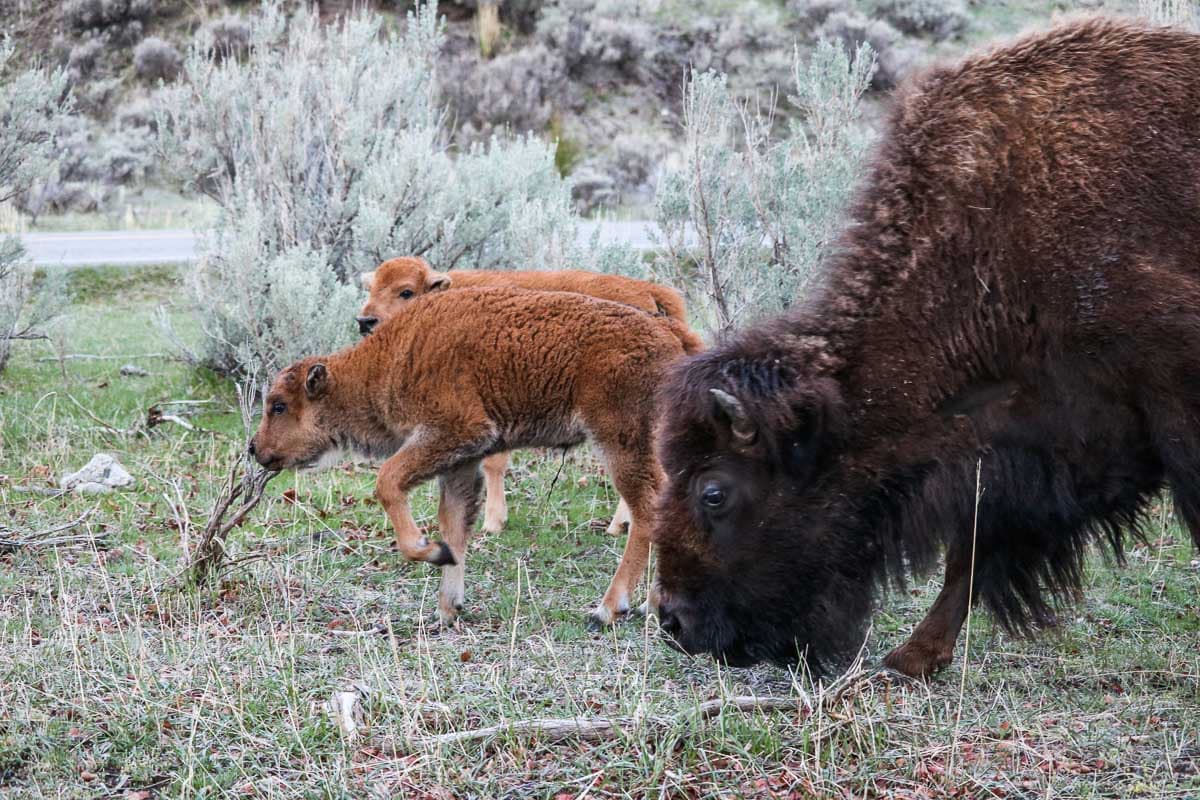
Where to Stay in Mammoth Hot Springs, Yellowstone
As I mentioned in the intro to this post, Mammoth Hot Springs is one of the main tourist hubs within Yellowstone National Park. It is nothing less than the gateway to the Northern Range, which comprises Blacktail Deer Plateau and the Lamar Valley in the northeast.
As such, there are a few different places you can stay at Mammoth Hot Springs, each offering more (or less) comfort and amenities, depending on what you prefer.
Mammoth Hot Springs Hotel and Cabins
The main place to stay at Mammoth Hot Springs is its eponymous Mammoth Hot Springs Hotel and Cabins.
Accommodation at this historic Yellowstone hotel is available in a variety of cabins, suites and deluxe rooms.
I stayed at the cabins at Mammoth Hot Springs. Although relatively basic, they did provide me with everything I needed to enjoy my time at Mammoth Hot Springs—heating during chilly nights, a comfy bed, and a hot shower.
You can grab food at the hotel, which is just a stroll away, or at the nearby Mammoth General Store.
From your cabin or room, you might see a herd of elk or American bison grazing in the surrounding hills or even at the lawn in the middle of the historic district.
The Mammoth Hot Springs Hotel and Cabins are open in both winter and summer, with brief closing periods in between the seasons.
In fact, along with the Old Faithful Snow Lodge, this is one of only two lodges in the national park that are open during the harsh Yellowstone winter.
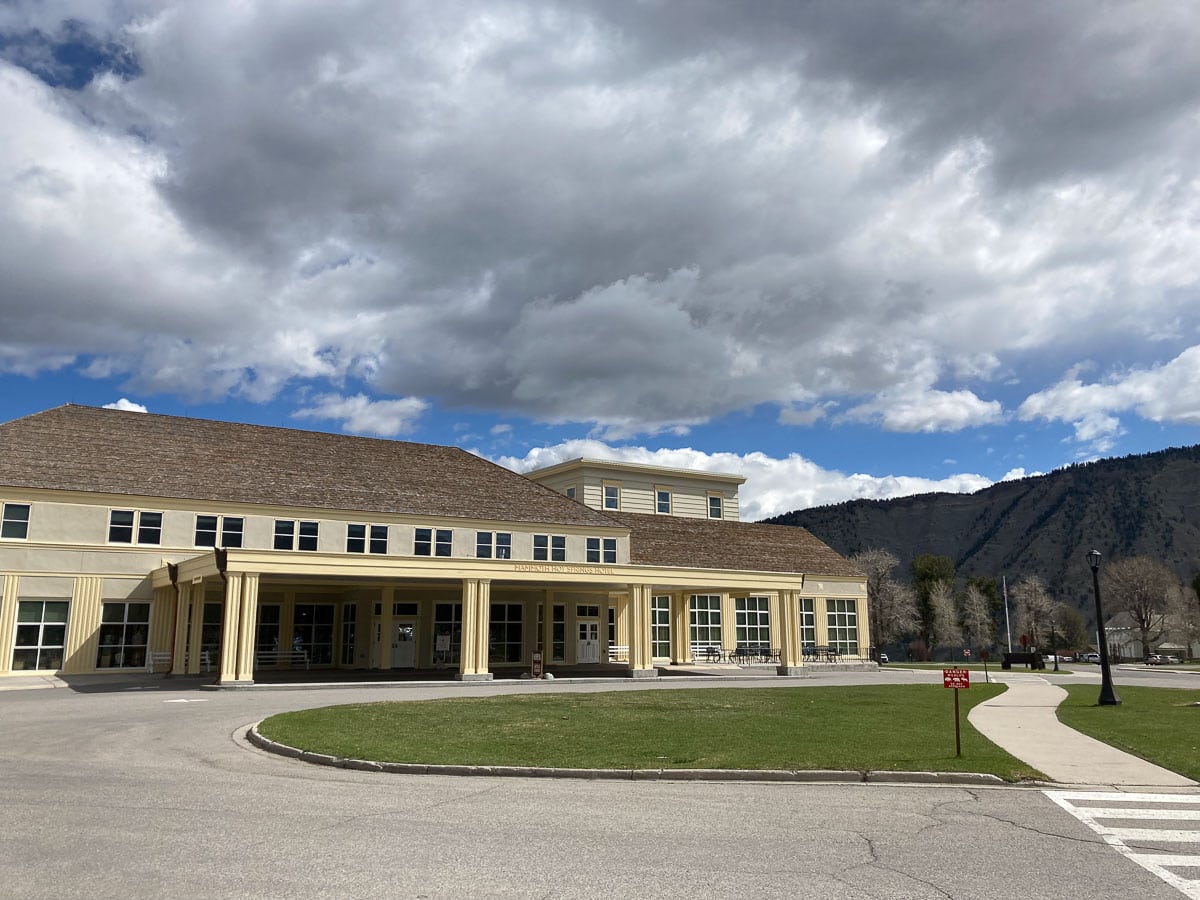
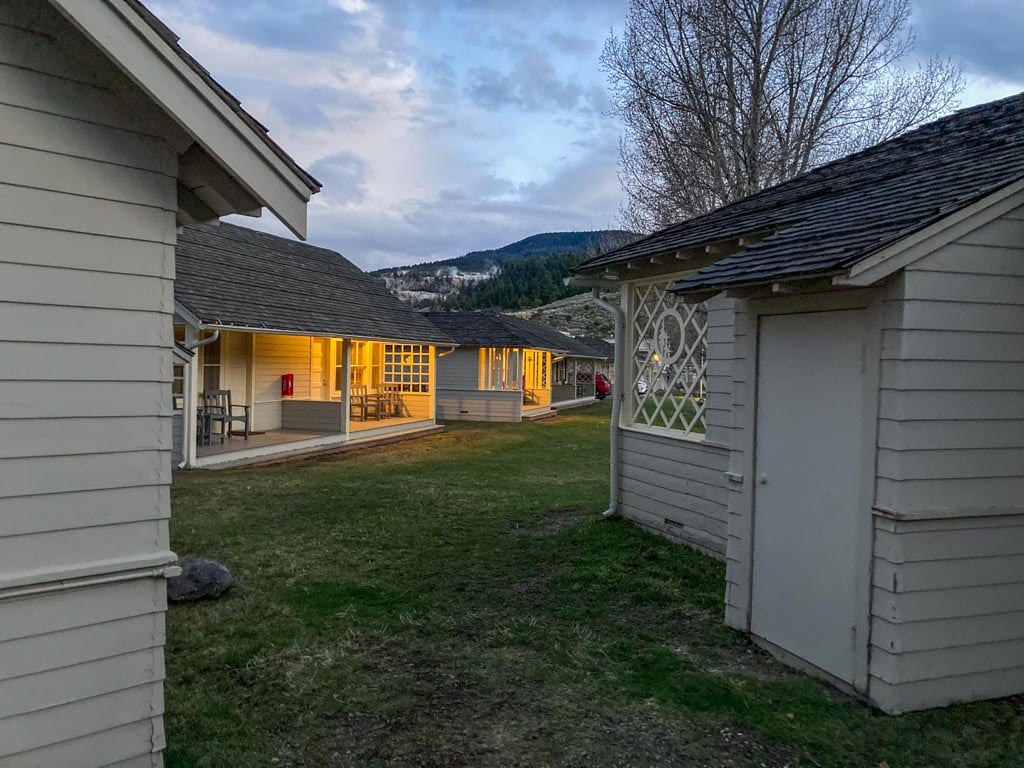
Mammoth Campground
Just outside of the Mammoth Hot Springs Historic District lies the popular Mammoth Campground. It’s about five miles south of the north entrance in Gardiner.
The only campground in Yellowstone that’s open year-round, the Mammoth Campground has 85 campsites, 5 of which are accessible.
Much of the campground is an open landscape of grasses and sagebrush, with some shade-providing Douglas firs and junipers scattered throughout.
Sites have a picnic table, fire pit, and bear-proof food storage lockers. Flush toilets are available throughout the year, but there are no showers.
More About Yellowstone National Park
- Park Website
- Travel Guide
- Topographic Map
- Top Places to Visit in Yellowstone National Park
- Best Spring Hikes in Yellowstone National Park
- Where to See Wildlife in Yellowstone National Park
- Bear Hibernation in Yellowstone National Park
- Best Scenic Views in Yellowstone National Park
- Accommodation
Visiting Mammoth Hot Springs FAQs
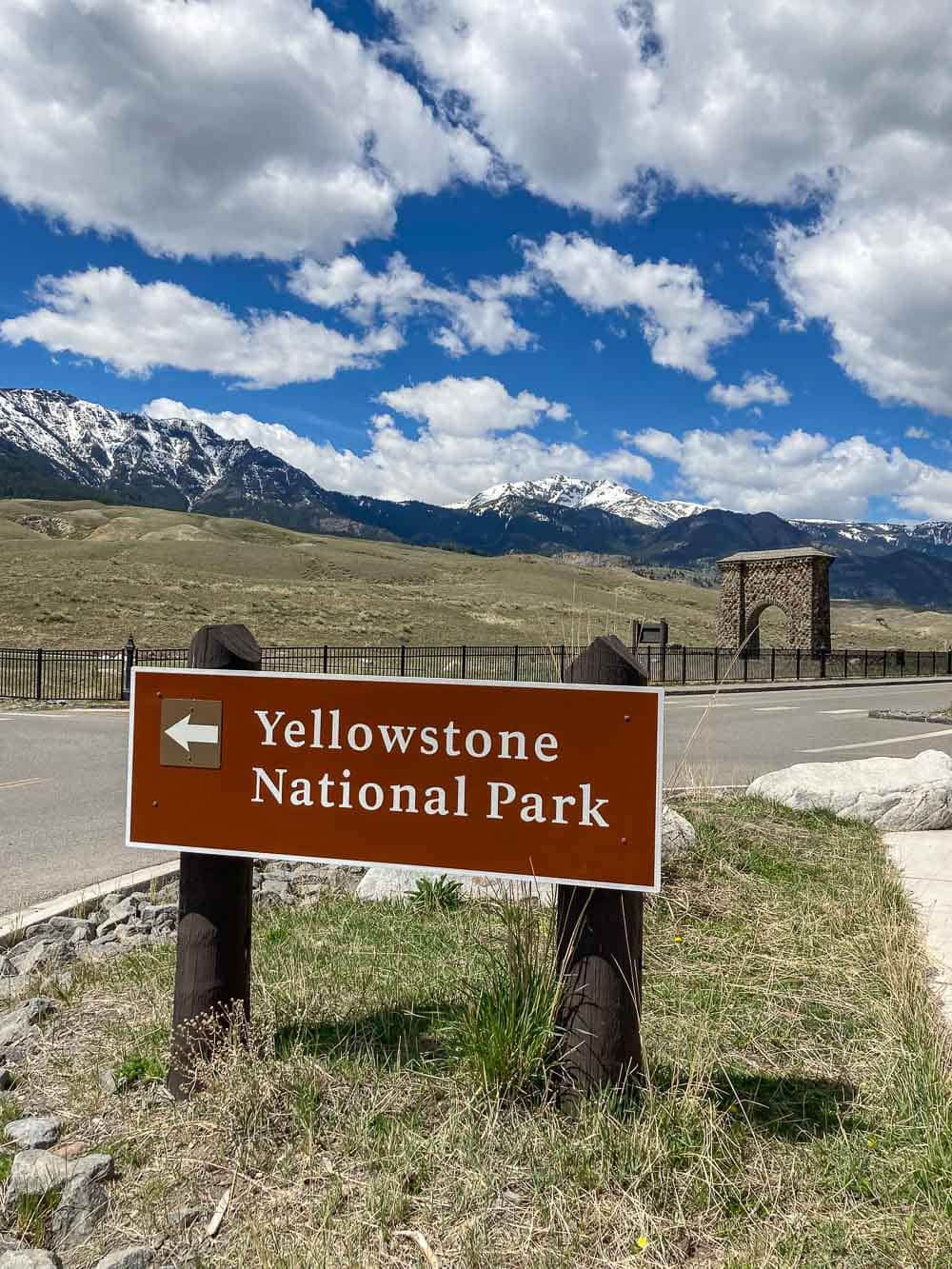
Where Is Mammoth Hot Springs?
Mammoth Hot Springs is a sprawling collection of colorful hot springs on a slope of travertine terraces in the far northwestern corner of Yellowstone National Park, Wyoming.
It is about 5 miles south of the park’s north entrance in Gardiner, Montana, and is part of the Mammoth Hot Springs Historic District.
How Many Days Do I Need to Explore Mammoth Hot Springs?
Although you could easily walk the Mammoth Hot Springs boardwalks and see Fort Yellowstone in one afternoon, I highly recommend spending at least two days here.
With some more time, you can go on half-day trips to places like Gardiner and the famous Roosevelt Arch, explore Blacktail Deer Plateau, and/or hike Bunsen Peak.
This will also allow you to spend more time enjoying the abundant wildlife that calls this part of Yellowstone home.
Is Mammoth Hot Springs Open Year-Round?
Yes, Mammoth Hot Springs is open all year-round. In fact, it’s one of just a couple of areas in Yellowstone National Park that don’t close in winter.
The road between Gardiner and Cooke City, Montana, remains open to traffic throughout the entire year. This is the road that runs across Blacktail Deer Plateau, to Tower-Roosevelt, and through the scenic Lamar Valley.
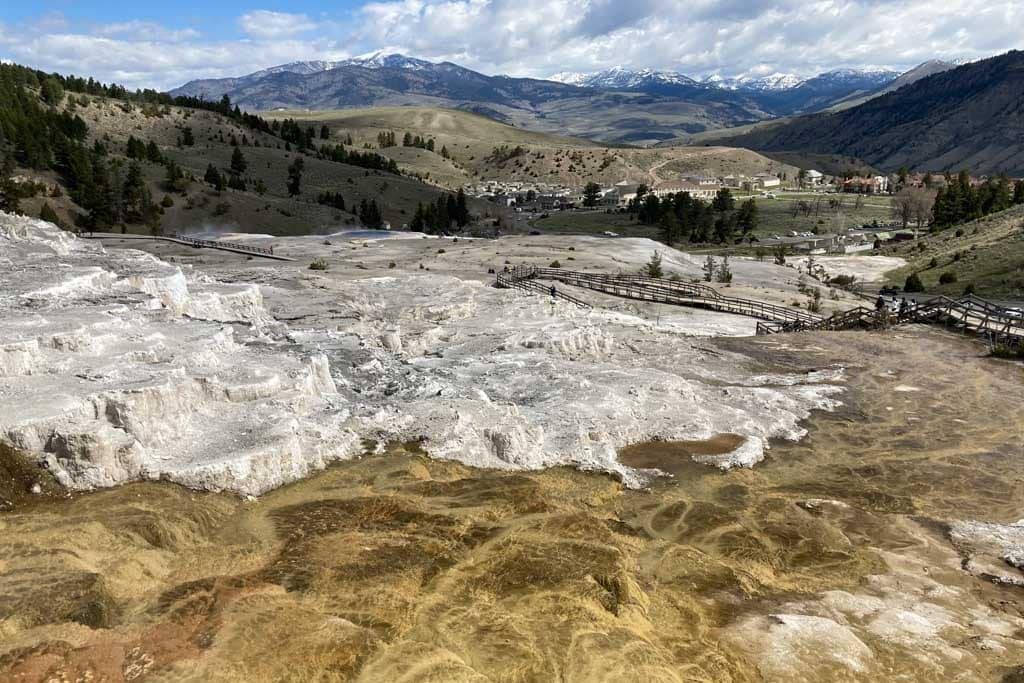
Can You Swim in the Mammoth Hot Springs?
No, absolutely not! Swimming, soaking, and wading is prohibited in all hydrothermal features in Yellowstone National Park for two reasons. The high temperatures of the hot springs are unsafe for visitors and swimming could damage these precious natural resources.
There are only two places in the park where swimming may be allowed, with a strong emphasis on “may.”
These are the Boiling River (which is currently closed due to the impact of the 2022 floods) and the Firehole Swim Area (which is only open in summer and may remain closed during years of high water and strong currents).
You can find more information about swimming in Yellowstone National Park here.
What Wildlife Can I See in the Mammoth Hot Springs Area?
Mammoth Hot Springs is home to a plethora of iconic Yellowstone wildlife.
Both elk and bison are present in the area year-round, even in winter, when they enjoy the relative warmth coming from the hot springs.
Uinta ground squirrels and chipmunks are common sights among the cabins, as well as around the trees and buildings of Fort Yellowstone.
To the north, especially in Gardner Canyon, look for birds like ospreys, eagles, and kingfishers, as well as bighorn sheep on the cliffs.
To the south, Swan Lake Flat is home to sandhill cranes, trumpeter swans, ducks, and geese, while you can sometimes also see bison, elk, wolves and grizzlies here.
At Blacktail Deer Plateau, visitors can see a wide range of animals, including mule deer, elk, bison, marmots, and grizzly and black bears.
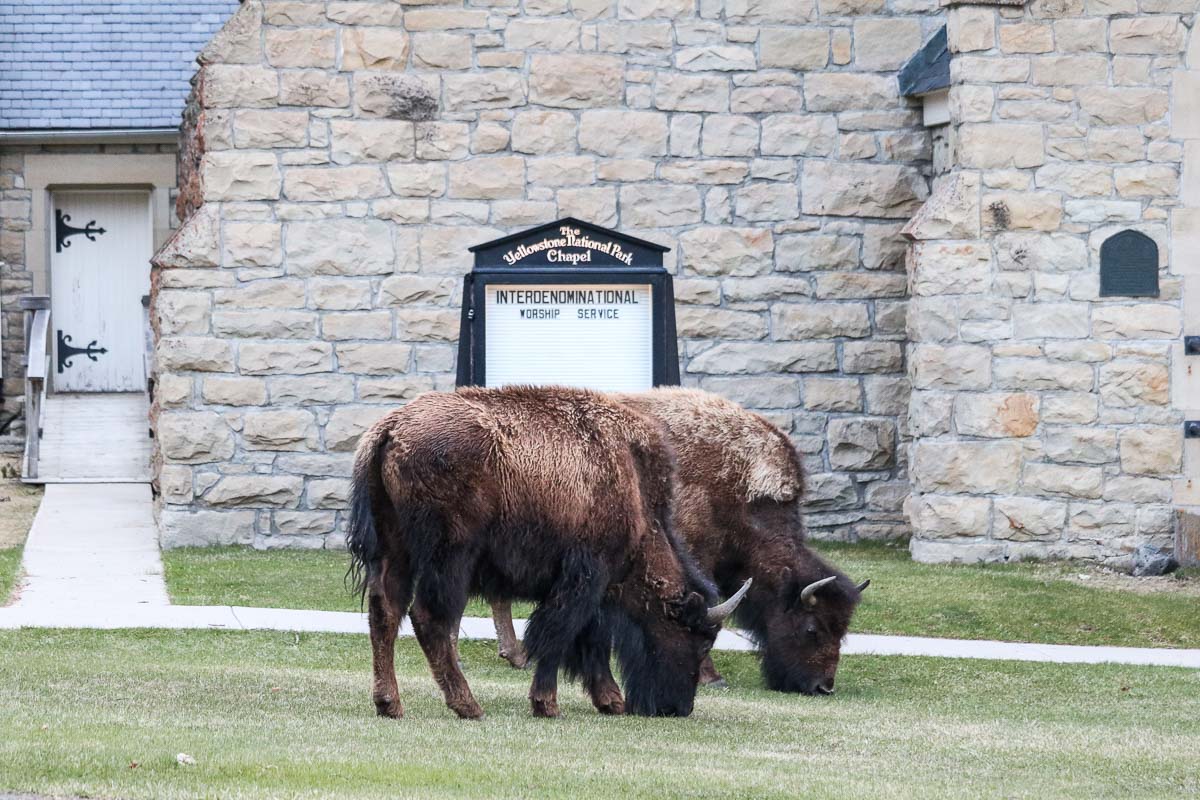
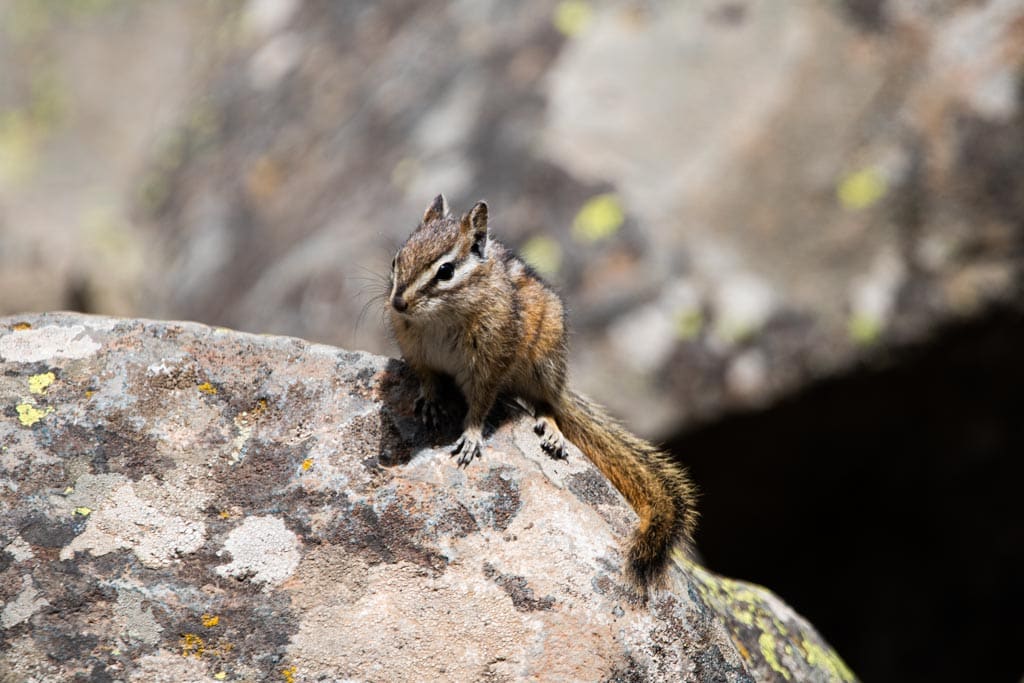
Do I Need a Reservation to Visit Mammoth Hot Springs in Yellowstone?
No, you do not need a reservation to visit Mammoth Hot Springs.
However, since this is within Yellowstone National Park, you do need to pay the park entrance fee, which can be paid at any of the park’s entrance stations.
Additionally, if you’d like to stay at the Mammoth Hot Springs Hotel and Cabins or camp at Mammoth Campground, I do strongly suggest getting a reservation in advance.
Check availability for the Mammoth Hot Springs Hotel and Cabins here, or book your campsite at Mammoth Campground here.
Which Visitor Services Are Available at Mammoth Hot Springs?
As one of the main tourist hubs in Yellowstone National Park, Mammoth Hot Springs has numerous facilities and services for visitors. Here’s a brief overview of the things available at Mammoth Hot Springs:
- Albright Visitor Center (exhibits, visitor information, permits, ranger programs, restrooms, souvenirs, and free Wi-Fi)
- Mammoth Hot Springs Hotel and Cabins (various accommodation options, including cabins with or without a bathroom, hotel rooms, and suites, plus a gift shop)
- Mammoth Campground (85 basic campsites)
- Gas station (gas and LP available)
- Albright Picnic Area in front of the visitor center (4 tables) and Mammoth Picnic Area across the road from Liberty Cap (9 tables)
- Mammoth Hotel Dining Room, Map Room Bar, and Terrace Grill (breakfast, lunch, and/or dinner)
- Mammoth Post Office (official USPS office)
- Mammoth General Store (groceries, snacks, ice cream, apparel, camp gear, souvenirs, and water bottle filling station)
You can find opening times and dates for all services at Mammoth Hot Springs here on the Yellowstone website.







